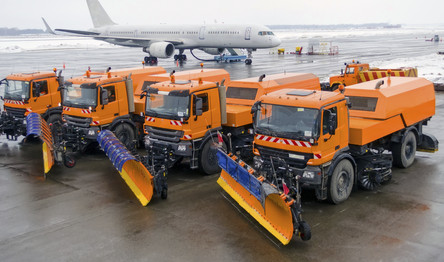The scope of application of municipal tyres is wide. Just one example of many is the classic municipal tractor, which keeps public roads clear during winter maintenance and drives water to municipal green spaces and trees during the summer. In addition to such small tractors, there are a whole range of other specialized vehicle types in municipal use, such as multicars, smaller yard loaders and sweepers. Sweeper-spray combinations, such as those used at airports to de-ice runways, also fall into the municipal segment - at least from a tyre perspective.
For airport applications, Bohnenkamp recently supported a wheel development for a European mechanical engineering company that designs, among other things, lift trucks for loading and unloading aircraft at airports. Bohnenkamp delivers the fully assembled wheels and special rims directly to the production line. The aforementioned manufacturer is just one of many that Bohnenkamp already supports in the development of their municipal vehicles, small tractors and similar machines and advises on the selection of tread and rim. In this context, Europe's leading wholesaler of commercial vehicle tyres recommends itself as a partner for series production from small to large. "Thanks to our large inventory and enormous assembly capacity, we may well be able to deliver several thousand fully assembled wheels for municipal use directly to a manufacturer's assembly line on schedule. That is one of our USPs," explains Gert Timmer. He heads the Agricultural, Forestry and Municipal Original Equipment business unit at the Osnabrück-based tyre specialist and knows most of the relevant vehicle manufacturers in the country. Many sweepers, multicars, small tractors, compact yard loaders or lawn mowing tractors in use in this country perform to their full potential also thanks to the extremely professional and precise support of Bohnenkamp's municipal tyre specialists. Gert Timmer's latest customers include Rawkar, a developer of amphibious vehicles. The versatile, four-axle machine is intended to support fire departments, among others, and will also roll off the production line with municipal treads from the Bohnenkamp range as soon as production starts.
The growing number of vehicles for niche applications is just one reason for the success trend in municipal tyres. The range also follows the need for an ever-increasing fan base for compact tractors in agriculture and forestry operations. The machines are popular; they can maneuver in small spaces and enter low buildings - barns and sheds in the countryside, parking garages and garages in the city. "Almost every horse farmer owns a municipal tractor these days, and I know one user who drives his municipal tractor every morning to get his newspaper from the mailbox. But of course that's not the main purpose," laughs Svend Burkhard. The head of Bohnenkamp's Lübeck branch is responsible for the so-called small tyre segment at the tyre wholesaler. In addition to quad, wheelbarrow and lawn mower treads, this division also includes the growing family of municipal tyres at the commercial vehicle tyre wholesaler.
Strictly observe the application range of municipal vehicles when selecting tyres
"Each of the countless possible uses of these tractors requires treads that are as specially tailored as far as possible for optimal work results and maximum mileage," recalls Svend Burkhard. "It doesn't make sense to run a tractor with soft turf tyres in winter service or at a horse farm, where the concrete floor will wear out the tread in a very short time. A rugged farm tyre, on the other hand, can quickly wreak permanent havoc on a parking structure." With municipal tyres, he says, it's even more important than with large agricultural tyres, for example, to pay attention to the exact use scenario because mixed use scenarios are rarer. "For this we provide extremely sound application advice and are excellently positioned for any solution with our wide range of products."
Conversion of municipal tractors to track width and vehicle height
The most frequent customer request to Svend Burkhard and his Lüneburg team is the adjustment of a specific track width or outer width of a vehicle using the appropriate tread. One example among many: Although Germany is considered the world champion in standardization, the width of footpaths in Germany varies considerably between 1.50 and 3 meters. However, because a two-meter wide machine can hardly operate in a municipality with 1.70-meter wide sidewalks, the Bohnenkamp specialists are always in demand as conversion consultants. A track width that matches the mounted tool, such as a snow plough blade in winter use, is also frequently requested. If the desired dimension cannot be achieved via the tread alone, Svend Burkhard and his conversion specialists can gain additional centimeters via the appropriate offset of the rim. In this way, Bohnenkamp has even made many an ordinary small tractor fit for viticulture, which requires an extremely narrow track width. The height of municipal tractors can also be optimized by selecting the appropriate tread. This is necessary when a facility service provider or city sidewalk cleaning crew actually needs to enter a parking garage.
Bohnenkamp plans tyre sets for all common municipal tractor models
Thanks to Bohnenkamp's good contacts with the trade and manufacturers, the conversion specialists are well prepared for most scenarios; the exact dimensions of almost all current and soon to be released machines are known. Accordingly, the designs of countless sets of tyres for many different vehicles and targets are already ready at hand in the drawer. "With all the preparation, however, sometimes it really comes down to the last centimeter. Then we calculate combinations that would never occur in practice outside the scenario," reveals Svend Burkhard. He describes the unusual proportions that result from such calculations as follows: "If you have to cut 20 centimeters off the height, then the thing looks like a bockwurst with jacket potatoes and also only goes 15 km/h, because the size of the wheel is simply lacking for greater propulsion." No one would build such a tractor in series production, but sometimes it is needed.

